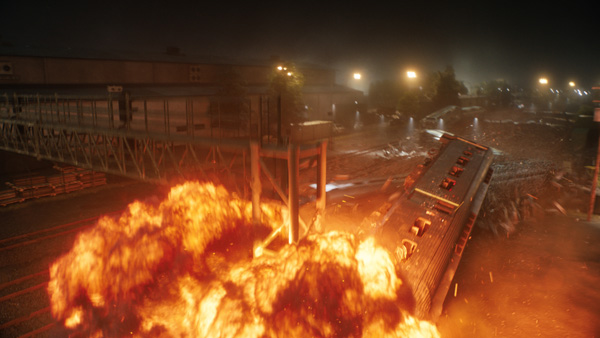
Cinesite was lead vendor and worked on over 800 shots for the recent high-action thriller 'The Commuter', directed by Jaume Collet-Serra. The film follows Michael, an insurance salesman on his regular train commute home. He meets a mysterious stranger who blackmails him into finding the identity of a passenger on his train before the last stop. He soon realises she is part of a conspiracy threatening his life and the lives of the other passengers, but has only the length of his journey to unravel their plot and prevent disaster. Nevertheless, the film ends in an explosive finish.
This is the kind of thriller in which visual effects come into their own for a director. Cinesite's team took over mundane, familiar-looking set pieces and turned them into locations full of intrigue, danger and massive explosions.
The wide scope and large volume of work called for the skills of artists at both of the company's studios in Montreal and London. Their shots involved creating train additions and set extensions for daylight environment shots, FX for bomb explosions, stitching multiple fight scene plates together into a single take, supporting stunt work with digital doubles and creating full CG environments. The team worked on the project from the start of principal photography in August 2016 through to delivery in August 2017.
On Set

The scope of this work also meant considerable involvement just before and during production. While the shoot was still underway, before post-production got started, Cinesite's VFX Supervisor Stephane Paris joined the production VFX Supervisor Steve Begg on-set at Pinewood and Longcross studios to advise the crew. When lighting and filming the dressed train carriage sets against bluescreens, it was important to make sure that reflections in the images were kept to a minimum and the screens were secure, so that Jaume would have enough creative freedom when working with Cinesite’s VFX teams later in post. Having close, direct interaction with Steve and Jaume from the beginning also gave the team a chance to be artistically involved, and contribute to the overall look of the action.
“The Tarrytown sequences were shot on set at Pinewood using blue screen and at Longcross Studios, with some location work at Worplesdon station near London,” said Stephane. “We had someone go over to the real Tarrytown north of New York, as well as surround areas to take photos for the digital matte paintings in our background extensions out past the parking lot trees.”
Stitching Up a Fight
Two major action scenes needed digital doubles to maintain their drama and believability, the first was a fight sequence between the main character Michael and another passenger on the train. “This was going to be a high-octane action scene but because it was filmed within the confined space of the train carriage, it required digital doubles to aid the transitions between the plates, as well as through the environments and train infrastructure in many instances,” Stephane said. “By relying on doubles to cover all the angles, the camera could move freely through the action and the divisions between the carriages. In several of the more physically demanding shots using stunt actors, we replaced their faces with the actors' faces.”
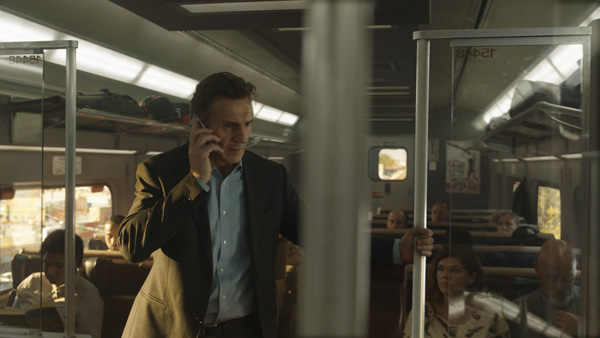
While using doubles in post certainly gives a director more control and flexibility for his story, the work does bring challenges. This fight scene, in fact, was a stitch of 14 different takes blended together to look like one long shot. The shot included action inside train carriages with interactive live-action lighting effects. “We had to create a seamless CG background to be displayed outside the carriages that included this interactive lighting. In addition, despite the excellent quality of the takes, there were significant camera and pose differences take-to-take, in what was supposed to be continuous action,” said Stephane.
“For instance, the perspective of the carriage, camera zooms and background deformation often were not smooth so it was necessary to re-project the carriage interior onto geometry to give more camera control over the shots for the multiple required transitions. This required a lot of creative matchmove and comp work to hide the transitions, as well as bridging CG elements that had to track across these takes.”
Their second digital double was created for Michael’s dramatic jump across the two carriages. The jump was a CG takeover between the stunt man, who features at the start of the shot, and Michael's actor Liam Neeson at the end, in one seamless transition. The hero carriage, with the passengers inside, narrowly avoids the elevated carriage, derailing and rotating before grinding to a stop just outside the station and the end of the line bumpers.”
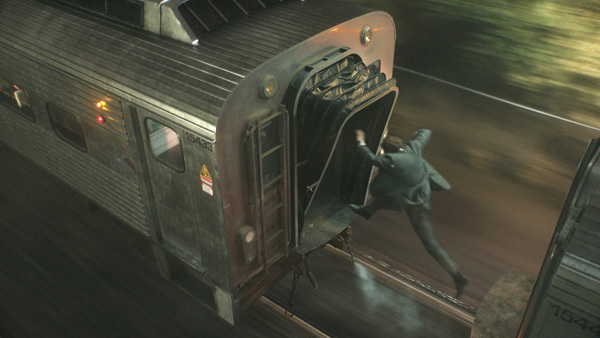
Setting the Stage
The climatic train crash is the key sequence in the story, and involves events unfolding underground as well as at the surface. Creating the environments with the right looks, light and configuration, the first step, was critical.
Stephane said, “The crash has to be understandable as well as graphic and realistic, so the audience could easily follow the action and understand the immediate danger the passengers are in. Also faced with the challenge of having no suitable underground location, we created the entire scene in CG to replace the physical location and Beacon yard where the shoot was held, building a digital set where we could match Jaume’s vision in terms of action.”
Cinesite's 2km asset of the environment, built in Nuke, is complete with a station yard dressed with buildings, tracks, trains and general industrial content and a large curved section of track. It needed to align precisely with a section of real set built at Longcross Studios for shots of the passengers disembarking the end carriage, and includes the large curved section of track to match with the action. For complete accuracy, the physical set piece was captured using photogrammetry.
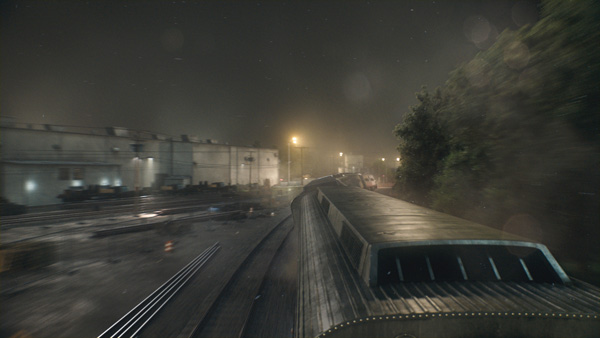
Subway
Underground, only limited filming was possible on the New York City subway, due to tight restrictions. Space was also limited owing to the narrow structure of the carriage. “To manage these limitations, three cameras were pointed out of a side window achieving a 130° panorama, with a front facing camera about 10 to 15 metres away,” Stephane said. “Because of the distance between the two rigs it was not possible to stitch the front and side views together. Furthermore, what was shot was not particularly dynamic and didn't really show the distinctive cavernous stations in the subway system with the familiar big columns, pillars and lighting.”
Action was shot in the dressed bluescreen carriage at Pinewood Studios and, ultimately, the team built a CG asset for this environment as well, making sure it was flexible enough to be used in multiple shots. The walls, platforms and exteriors were all created in CG, complete with cable systems, columns, tracks and so on, and joined together to create a kilometre-long section of tunnel, rendered through eight cameras and projected onto geometry. It proved to be a useful tool.
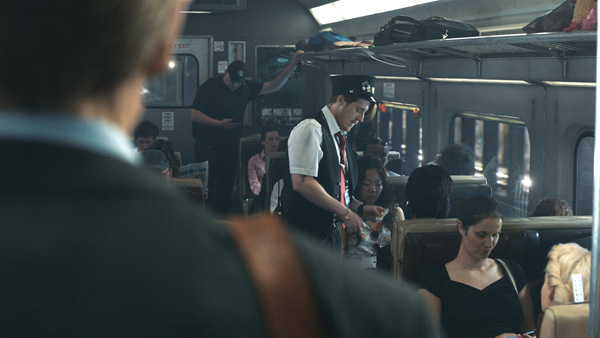
Stephane said, “It meant that for any shot we could track the camera, drop our asset into the environment and have the required control over the lighting to ensure it matched the lighting used to shoot the actors. Using this system, we were also able to achieve continuity between shots and limit environment repetition. Although the set-up was heavy, its flexibility really paid off and we ended up using it in approximately 200 shots.”
Beautiful Blow-up
The team at Nvizible in London handled all the initial previs for the train crash. Steve Begg had everything blocked out and then sent it to Jaume for initial feedback, but the final train crash layout was done by the team with Jaume at Cinesite.
“During the pre-production phase, the previs for the full CG crash hadn't been totally locked off, because some adjustment was still required for editing, camera movement and set dressing,” said Stephane. “We knew for example that the train, once derailed, would have to hit some electrical pylons, breaking them and snapping their wires. But the big question during pre-production was which pylons – we had at least four variations – and how could we keep to the schedule, pre-empting possible last-minute changes? We came up with a procedural solution, able to switch from a two-mast set to a three- or four-mast set so that we wouldn't need to start the shot from scratch all over again if the requirements changed.”
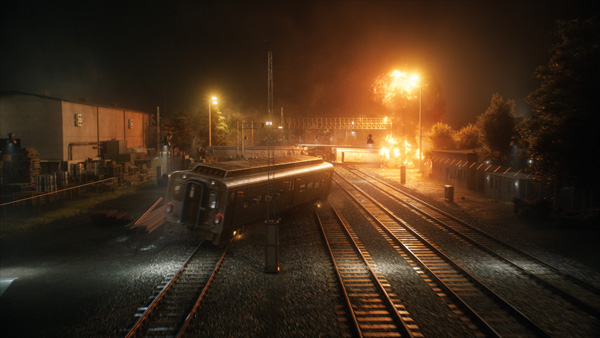
FX were key, with flying gravel, breaking and deforming tracks, exploding sleepers as well as fog, dust, smoke and fire. Houdini simulations were mainly used, with some Maya for falling pieces of train. The extent of the FX was a challenge to the team, as well as ensuring that continuity was maintained in the destruction elements. Stephane noted, “The compositors added additional smoke and dust, controlling the volumetrics to keep a good balance and deliver additional drama. The compositors did a fantastic job, enhancing the shots artistically. They really made them beautiful.”
Heavy Lifting
The heavy FX work run in Houdini mainly used the FEM solver and cloth components to art-direct the train destruction itself, simulating the bending and shearing metal panels, shattering windows and other features. The results were used as collision objects for the environment destruction and volumetric effects such as the explosions and smoke/dust, all using Houdini’s RBD, particle and fluid simulation processes. The artists simulated the crash interaction with the environment and destruction of track rails and sleepers, track gravel ballast, dirt and particulate passes, as well as subsequent dust kick-up and smoke trails from these elements.
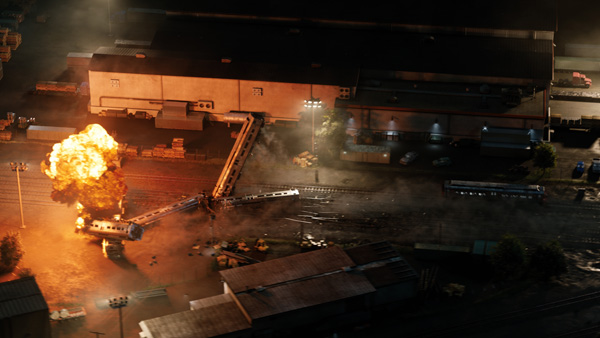
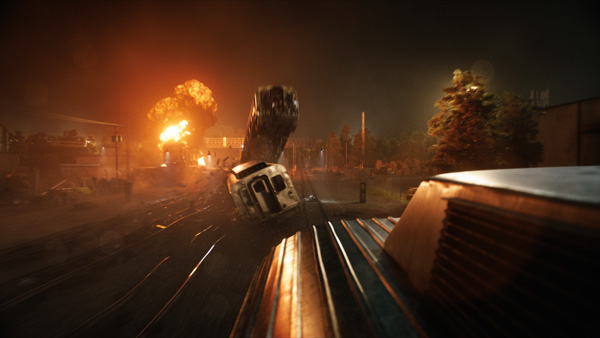
“Metaphorically speaking, I’ve destroyed plenty of things in my career,” Stephane commented. “I destroyed Silverton High School during a graduation ceremony in 'Into the Storm' and the fighting robot Mimic in 'Edge of Tomorrow' to name a few examples. But strangely enough, finding proper references that fit this particular action movie's requirements became a challenge
“Footage of derailing trains is not so easy to find, and when you do find it you quickly notice that train carriages are not designed to tear and break the way you would like them to in an action movie! Naturally, they are constructed to be safe, with lots of energy absorption compartments and equipped with auto triggering safe mechanisms. So, putting reality aside, we devised a visually exciting and dangerous movie train crash for Jaume, complete with lots of metal crumbling, shattering windows and multiple large-scale impact explosions.”
Daylight Environments
Aside from the big VFX crash and fight sequences, the main body of Cinesite's work was equally important to the impact of the story, if less exciting, comprising about 400 shots showing daylight environments of the moving train exterior. The material formed a long sequence, shot under different lighting conditions and environments that had to play within the CG environment surrounding it.
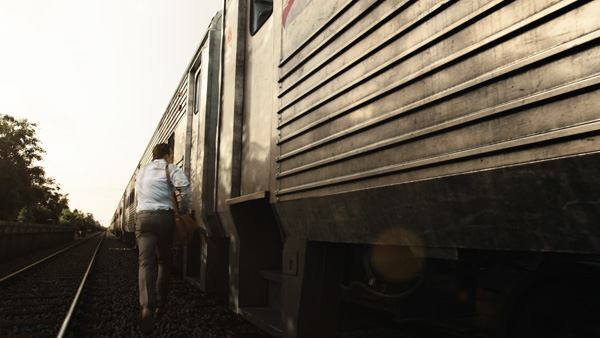
“In this section of the movie, apart from a few shots captured from a helicopter, whenever we see the outside of the moving train itself, as well as the environments, all of the imagery is digital. To an extent, we were trying to match to a real sequence of exteriors that the train might have passed through along this route. Steve Begg and his team went in and around New York and filmed 360° elements from the back of a truck, as well as from trains and a helicopter,” said Stephane.
“So, while the journey is based on a real route, it was not possible to shoot the exact line from the story. Instead, similar environments and locations were selected, based around New York’s Northern Line, and Steve and editorial then chose backgrounds by matching them with the appropriate section of the action.”
Not surprisingly, reflections and lighting in the live action shots with the actors often did not match the selected exterior environments, which required clean-up and extensive keying. Many of the live-action lighting cues were very difficult to reconcile with the creative requirements for time-of-day and location. Sometimes toning down the live action was required, and at other times it was necessary to add extra lighting to better synchronise the elements together. Stephane said, “Making this work required constant, continuous back and forth with layout and lighting to get buildings, trees and other occluding objects lined up properly with the on-set look and camera cuts.” www.cinesite.com
Words: Adriene Hurst
Images: ®2018 STUDIOCANAL


















